Migrating large numbers of teams requires careful planing. The teams could belong to different offices and geographical locations or sensitive departments. Migrating teams of Finance or Legal departments require special care. Organize the teams into collections to make large team lists more manageable.
Working with the Collection Dashboard
The Collection Dashboard shows the collection-specific summary, allows you to see teams added to it, create tasks for them, and monitor the progress of tasks.
- To view the collection dashboard for an existing collection
- Log in to Quest On Demand and choose an organization if you have multiple organizations.
- From the navigation pane, click Migration to open the My Projects list.
- Create a new project or open an existing project.
- From the project dashboard, click Open in the Teams tile to open the Teams workspace.
- From the top-right corner of the workspace, click Select Collection and then select the collection to view. The collection Dashboard is displayed.
- Open the Teams tab. You will see the list of teams that belong to the collection.
- To see the tasks for collection-specific accounts, use the corresponding tile on the collection Dashboard or open the Tasks tab.
- To see the events related to the collection, use the corresponding widget on the collection Dashboard or open the Events tab.
- To rename or delete the collection, click the corresponding buttons in the menu.
- To return to the project dashboard, click the project name in the navigation bar.
Creating a Collection manually
- From the project dashboard, click Open in the Teams tile to open the Teams dashboard.
- From the top-right corner of the workspace, click Select Collection > + New Collection
- Enter a collection name and click Save to add this collection to the project.
Adding teams to Collections
You can add teams to collections in several ways:
To add selected teams to a new collection:
- From the project dashboard, click Open in the Teams tile to open the Teams dashboard.
- Click the Teams tab and select List View if not already selected.
- Select the teams you want to add to the collection.
- From the actions toolbar, click New Collection. The New Collection dialog opens.
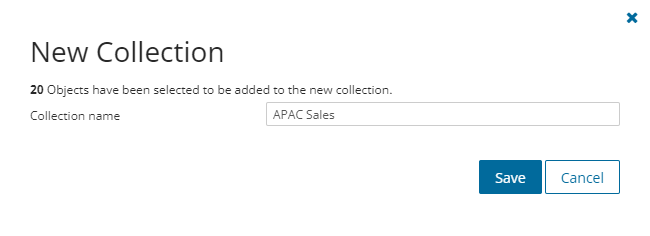
- Enter a collection name in the Collection name field and click Save to add the selected teams to the collection.
To add selected teams to an existing collection:
- From the project dashboard, click Open in the Teams tile to open the Teams dashboard.
- Click the Teams tab and select List View if not already selected.
- Select the teams you want to add to an existing collection.
- From the actions toolbar, click Add To Collection. The Add to existing collection dialog opens.

- Select a collection from the Collection name dropdown and click Save to add the selected teams to the collection.
To add teams from a CSV file to a new or existing collection from the Teams tab:
This is a two-step process as described below to add teams to an existing collection from the Teams tab:
Step 1: Prepare the CSV file
|

|
NOTE: CSV file names with non-ASCII characters are not supported. Teams in the CSV that have not been discovered cannot be added to a collection. |
Use the format shown below to prepare the CSV file. The minimal set of columns required are shown.
|

|
TIP: You can export the selected teams to a CSV file and then add the Collection column and retain the Source MailNickname column. All other columns in the exported CSV file will be ignored so you can remove those columns if you want. |
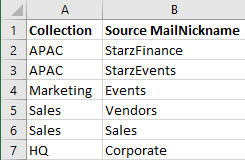
- Collection - Column header for the collection name
- Source MailNickname - Email alias of the M365 group of the team. You can get the Source MailNickname property of the teams when you export teams to a CSV file. Source MailNickname values are case-sensitive.
Step 2: Import the CSV file
- Log in to Quest On Demand and choose an organization if you have multiple organizations.
- From the navigation pane, click Migration to open the My Projects list.
- Create a new project or open an existing project.
- Click the Teams tile, or click Open from the Teams tile to open the Teams workspace.
- Open the Teams tab.
- From the actions toolbar, click More Actions > Import Collections. The Import Collections from File dialog opens.
- Select Teams/M365 groups from the Specify kind dropdown.
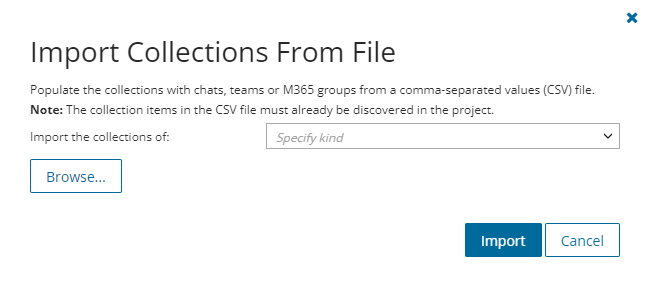
- Click Browse and select the CSV file. The selected CSV file name appears.
- Click Import.
|

|
NOTE: If a collection in the CSV does not exist, a new collection will be created with the name specified in the CSV. |
To add teams from a CSV file to an existing collection from the Teams collection dashboard:
This is a two-step process as described below to add teams to an existing collection from the Teams collection dashboard:
Step 1: Prepare the CSV file
|

|
NOTE: CSV file names with non-ASCII characters are not supported. Teams in the CSV that have not been discovered cannot be added to the collection. |
Use the format shown below:
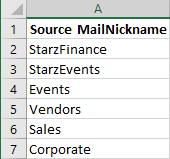
Source MailNickname - Email alias of the M365 group of the team. You can get the Source MailNickname property of the teams when you export teams to a CSV file. Source MailNickname values are case-sensitive.
Step 2: Import the CSV file
- From the project dashboard, click Open in the Teams tile to open the Teams workspace.
- From the top-right corner of the workspace, click Select Collection and then select the collection.
- Click Fill From File from Teams collection Dashboard menu. The Fill from File dialog opens.
- Click Browse and select the CSV file that you created.
- Click Populate to add the teams from the file to the collection.
To export teams to a comma-separated values (CSV) file:
- Click Teams from your migration project
- Click the Teams tab. From the Teams List View select the teams you want to export.
- From the Teams List View select More Actions and then select Export.
- Open the CSV file by extracting it from the ZIP file that is downloaded to your computer.
The exported data contain the following information:
- Team Name - source team name
- Workflow - (deprecated) the most recent operation performed on the team
- Channel, Members, Messages, Plans, Tasks - counts of various content in the team.
- Size(MB) - size of all the content in the team.
- Last Activity - date and time of the last action performed on the team record.
- Created - date and time the team record was created
- Target Team Name - suggested target team name that will be provisioned in the target tenant
- Source MailNickname - email alias of the associated Microsoft 365 Group. This value will be used for the mail enabled object and will be used as PrimarySmtpAddress for this Microsoft 365 Group. The value must be unique across your tenant.
- Last Operation Description - description of the last operation performed on this team.
You can rename and map teams, or rename, map and merge one or more source teams to a specific team in the target tenant in two ways:
Mapping and Renaming Teams from the Teams list
- Log in to Quest On Demand and choose an organization if you have set up multiple organizations.
- From the navigation pane, click Migration to open the My Projects list.
- Create a new project or open an existing project.
- Click Teams from the project tiles, or click Open from the Teams tile.
- Go to the Teams tab and select one or more teams from the Teams list that you want to rename and map.
- Click More Actions and then click Rename and Map. The New Teams & Groups Rename and Map Task wizard opens.
- Step 1: Mapping options
- Enter the information as described below:
- Add prefix - specify a prefix for the team name.
- Add suffix - specify a suffix for the team name.
- Click Next.
- Step 2: Notification
- Send notification email once the task is completed - select this option to send a notification email when a mapping task completes.
- Only in a case of failure - select this option to send the email if the mapping task fails to complete successfully.
- Recipients - enter the email address of the recipients of this email. You can specify multiple recipient email addresses separated by semicolon.
- Click Next.
- Step 3: Schedule
- Choose from one of three options to schedule the task. The scheduler will be activated only after you complete the task wizard.
- Run now - task runs immediately.
- Run later - task must be started manually.
- Schedule - task will be started at a future date and time entered in the corresponding calendar field.
- Click Next.
- Step 4: Summary
- Verify the task specifications as described below:
- Name - name of the task. You can specify a custom name. The default name is Rename and Map Task.
- Source tenant - name of the tenant in this project.
- Target tenant - name of the target tenant in this project.
- Scheduled start - date and time when the task will start. Now indicates that the task will start immediately.
- Click Back to revise or review a previous step or click Finish to complete the task wizard and start the task as scheduled.
The task is created. You can track its progress from the Tasks tab, view the summary on the Dashboard or monitor alerts and notifications from the Events tab.
Mapping, Renaming and Merging Teams Manually from a File
To rename teams or merge one or more source teams to a specific team in the target tenant, a CSV file is used to indicate the mapping between source and target teams, as described below.
|

|
NOTE:
When teams are renamed and provisioned in the target tenant, Microsoft creates a default OneNote tab. Since ODM migration service is not aware of this default tab, any OneNote content that is migrated will retain the original name and will not appear in the default target OneNote tab of the renamed team.
There are two scenarios with OneNote migration when teams are merged:
- When one or more teams are merged to a team with a different name in the target tenant, Microsoft creates a default OneNote tab for the renamed target team. Since ODM migration service is not aware of this default tab, any OneNote content that is migrated will retain the original name and will not appear in the default target OneNote tab of the renamed team.
- When one or more teams are merged to a team with a preexisting team in the target tenant, contents in the OneNote tab in the target tenant is overwritten with the content from the source.
|
To create the mapping file:
- Prepare a comma-separated values (CSV) file with the source and target team names.
|

|
TIP:
- Export selected teams to a comma-separated values (CSV) and then edit this file. See Exporting Teams for more details.
- You can download a CSV template when you start the New Mapping from File Task wizard and click Download Example File from the Mapping File step.
- CSV file names with non-ASCII characters are not supported.
|
- The header row defines the names of the source and target attributes used for mapping. Subsequent rows list the mapping values of the attributes.
The columns are as follows:
- Source Mailnickname - unique name of the source team. The following column header variations are supported: SourceMailNickname, Source MailNickname, Source MailNickName. The column header is case sensitive.
- Target Mailnickname - unique name of the target team. The following column header variations are supported: TargetMailNickname, Target MailNickname, Target MailNickName. The column header is case sensitive. You can merge multiple source teams to a single target team when you specify the same Target Mailnickname in a mapping file.
- Target Team Name - display name of the target team. The column header is case sensitive. If two or more records have the same Target Mailnickname then the Target Team Name for each record must be specified and must be the same.

Example 1: Row 2: Simple change of name
The name properties of the source team will change to the Target Mailnickname and Target Team Name respectively.
Example 2: Rows 3 and 4: Different target teams with the same display name
The Target Mailnicknames are different but the Target Team Names are the same. The Target Mailnickname takes precedence and the teams will be mapped to distinct Target Mailnicknames but the display name of each target team will be the same. It is recommended that you use unique display names to avoid confusion.
Example 3: Rows 5, 6 and 7: Merge multiple source teams with the same target team
The Target Mailnickname is the same. The teams will be merged with the same target team with the specified display name.
- Save the CSV file. You may rename the file if needed.
To upload the mapping file:
- Log in to Quest On Demand and choose an organization if you have multiple organizations.
- From the navigation pane, click Migration to open the My Projects list.
- Create a new project or open an existing project.
- Click Teams from the project tiles, or click Open from the Teams tile to open the Teams dashboard.
- Click the Teams tab.
- Click More Actions and then click Map from File. The New Mapping from File Task wizard opens.
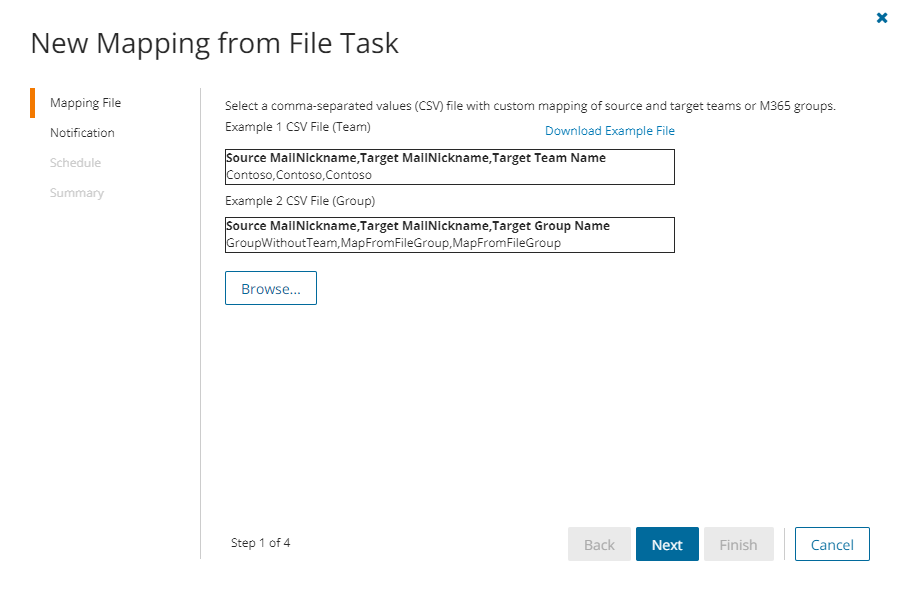
- Step 1: Mapping file
- Click Browse and select the CSV mapping file. The selected file name appears next to the Browse button.
- Click Next.
- Step 2: Notification
- Send notification email once the task is completed - select this option to send a notification email when a mapping task completes.
- Only in a case of failure - select this option to send the email if the mapping task fails to complete successfully.
- Recipients - enter the email address of the recipients of this email. You can specify multiple recipient email addresses separated by semicolon.
- Click Next.
- Step 3: Schedule
- Choose from one of three options to schedule the task. The scheduler will be activated only after you complete the task wizard.
- Run now - task runs immediately.
- Run later - task must be started manually.
- Schedule - task will be started at a future date and time entered in the corresponding calendar field.
- Click Next.
- Step 4: Summary
- Verify the task specifications as described below:
- Name - name of the task. You can specify a custom name.
- Source tenant - name of the tenant in this project.
- Target tenant - name of the target tenant in this project.
- Scheduled start - date and time when the task will start. Now indicates that the task will start immediately.
- Click Back to revise or review a previous step or click Finish to complete the task wizard and start the task as scheduled.
The task is created. You can track its progress from the Tasks tab, view the summary on the Dashboard or monitor alerts and notifications from the Events tab.
The provisioning task help you to perform the following:
- Provision teams in the target tenant.
- Resolve naming conflicts.
Considerations
- After all source teams are discovered you can begin provisioning teams on the target tenant with a Teams Provisioning Task. Verify that all associated accounts are matched or migrated before you create the provision task.
- When teams are provisioned, the account that is assigned the Migration Manager role will be added to the source teams, private channels and shared channels to prepare for migrating the channel settings to the target tenant.
- If one or more new private channels or shared channels are added to a source team after provisioning, then you must re-provision the team in the target tenant to ensure that the SharePoint content is discovered for those new channels.
- When teams are provisioned on the target tenant, a Discover SharePoint Contents Task is run. The task discovers the corresponding SharePoint site collection and its contents listed in the SharePoint Contents tab.
- Teams in the target tenant may take up to 24 hours to be fully provisioned by Microsoft.
To start a Teams Provisioning Task:
- Log in to Quest On Demand and choose an organization if you have multiple organizations.
- From the navigation pane, click Migration to open the My Projects list.
- Create a new project or open an existing project.
- Click Teams from the project tiles, or click Open from the Teams tile to open the Teams dashboard.
- Select one or more teams from the Teams List View.
- Click Provision. The New Teams Provisioning Task wizard opens.
- Step 1: Provision Options

- Choose from the following options if a team with the same name exists on target:
- Provision a new team on the target with the original name plus suffix - Select this option to provision a new team on the target tenant by adding a suffix to the team name.
- New team display name suffix - The default suffix is Migrated. You can specify another suffix.
- Merge to the existing team on target - Select this option to merge a team in the source tenant with a team in the target tenant that has the same name. Then select an option if a team channel with the same display name already exists in the target team:
- Provision a new channel on the target with the original name plus suffix - Select this option to provision a new team channel on the target tenant by adding a suffix to the channel name.
- New channel display name suffix - The default suffix is Migrated. You can specify another suffix.
- Merge source channel conversations with the Target channel - Select this option if the target channel is empty.

- Preferred location in target multi-geo tenant - Leave the preferred data location as Default if the target tenant is a multi-geo tenant (see Microsoft 365 Multi-Geo). All teams and groups will be migrated to the same region as the target admin. Alternatively, select the geo location configured for the target tenant.
|

|
TIP: To migrate teams/groups to different regions, the best practice is to create a collection for each region (see Managing Teams with Collections ) and add the teams/groups to the appropriate collection. Example collection names are "Migrate to EUR", "Migrate to JPN" and "Migrate to NAM". Use the collection as a filter to create the provision task. |
- Suppress Group Welcome Message - Select this option to prevent spamming users with welcome messages when Teams are provisioned on the target tenant.
|

|
NOTE: Suppressing these messages may result in performance degradation due to issues with Microsoft’s synchronization behavior. We suggest you check the performance during the pilot migration. |
- Click Next.
- Step 2: Notification
- Send notification email once the task is completed - select this option to send a notification email when a provisioning task completes.
- Only in a case of failure - Select this option to send the email if the provisioning task fails to complete successfully.
- Recipients - enter the email address of the recipients of this email. You can specify multiple recipient email addresses separated by semicolon.
- Click Next.
- Step 3. Schedule
- Choose from one of three options to schedule the task. The scheduler will be activated only after you complete the task wizard.
- Run now - task runs immediately.
- Run later - task must be started manually.
- Schedule - task will be started at a future date and time entered in the corresponding calendar field.
- Click Next.
- Step 4: Summary
- Verify the task specifications as described below:
- Name - name of the task. You can specify a custom name. The default name is Provision Teams.
- Source tenant - name of the tenant in this project.
- Target tenant - name of the target tenant in this project.
- Scheduled start - date and time when the task will start. Now indicates that the task will start immediately.
- Click Back to revise or review a previous step or click Finish to complete the task wizard and start the task as scheduled.










